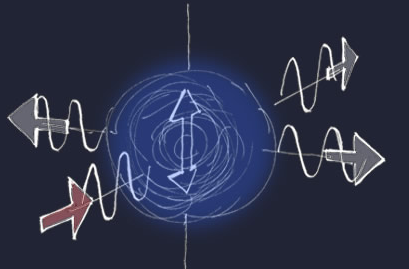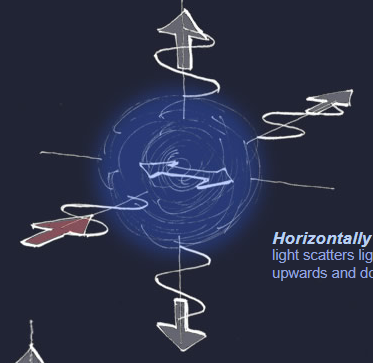Sky polarization, Istanbul - OPOD
Sky Polarization: Revealing the Hidden Beauty of Istanbul
When we gaze at the sky, we often overlook one of its most captivating features - sky polarization. While our unaided eyes may not perceive it, photographers have long been aware of this phenomenon and have skillfully used it to enhance the contrast between the sky and clouds in their images. In this article, we will delve into the fascinating world of sky polarization and explore its effects over the Golden Horn in Istanbul.
Unveiling the Science Behind Sky Polarization
To understand sky polarization, we must first grasp the concept of polarization itself. Direct sunlight is unpolarized, meaning that the electric vectors of its radiation point in random directions around the ray direction. However, when light interacts with certain elements in the atmosphere, such as air molecules, its electric fields can align in non-random orientations, resulting in partially polarized light. Plane polarized light, characterized by oscillating electric fields confined to a single plane, is one type of polarized light.
Skylight: Scattering and Polarization
The blue hue of the sky is a result of sunlight scattering off individual air molecules. This scattering process not only gives us our beloved blue sky but also polarizes the light. Sky polarization is most pronounced at angles 90° to the sun, although it never reaches 100% polarization due to various factors. These factors include imperfections in air molecules as dipole oscillators, scattering by dust, moisture, and aerosol particles, as well as multiple scattering.
Unveiling the Darkened Sky: The Role of Polarizing Filters
While sky polarization may go unnoticed by the unaided eye, photographers have harnessed its power to create striking visual effects. By using polarizing filters, they selectively darken the background blue sky, thus increasing the contrast between the sky and clouds. This technique allows photographers to capture more dramatic and captivating images.
The Influence of Horizon on Sky Polarization
As sunlight nears the horizon, the polarization of the sky diminishes. This reduction in polarization occurs because the sunlight is scattered multiple times as it interacts with the atmosphere near the horizon. Consequently, the polarization direction becomes less distinct and is gradually lost.
The Mechanics of Sky Polarization
To further understand sky polarization, let's examine the mechanics of light interaction with air molecules. When vertically polarized light encounters an air molecule, its varying electric field induces oscillations in the molecule's electron cloud. These oscillations, in turn, produce outgoing light that is equally polarized. Conversely, horizontally polarized light scatters predominantly in upward and downward directions.
Visualizing Sky Polarization
To visualize the polarization of light, we can represent unpolarized light as a combination of superposed horizontal and vertical polarized components. When light is scattered at right angles by an air molecule, it becomes strongly polarized, with its electric vector perpendicular to the incident light direction. The blue sky, in particular, exhibits its strongest polarization in a plane perpendicular to the sun's position.
In conclusion, sky polarization adds an enchanting dimension to our atmospheric experiences. Although imperceptible to the naked eye, this phenomenon has captivated photographers who have skillfully harnessed it to create awe-inspiring images. Understanding the science behind sky polarization allows us to appreciate the hidden beauty of our surroundings and marvel at the intricate interactions between light and atmosphere. So next time you find yourself gazing at the sky, take a moment to ponder the wonders of sky polarization and the secrets it unveils.

Sky Polarization over the Golden Horn, Istanbul ~ An evening panorama by M. Rasid Tugral taken using a polarizing filter from Galata Tower. The low, 7� high, sun is off screen at right. At centre, over the Galata bridge, the sky darkens. To the south east at left, towards the Horn�s tip, it is light again. The central dark wedge is where the sky�s light is most strongly polarized. See below for a labelled view of Istanbul. Images ©M. Rasid Tugral, shown with permission
Direct sunlight is unpolarized. The electric vectors of its radiation point in random directions around the ray direction. Light becomes polarized, or partially polarized, when the electric fields or vectors have non-random orientations. Plane polarized light (there are other types) has the oscillating electric fields all in one plane.
Skylight is sunlight scattered by individual air molecules. The scattered light is richer in short wavelengths giving us a blue rather than black sky and the light is also polarized.
Blue sky is most strongly polarized in directions 90° to the sun. The polarization there is never 100% - (1) because air molecules are not perfect dipole oscillators, (2) there is scattering by dust, moisture and aerosol and (3) the is some multiple scattering.
Unaided eyes hardly notice sky polarization but it is no secret to photographers who have long exploited it to increase contrast between sky and clouds. Light scattered by clouds is unpolarized and a polarizing filter selectively darkens the background blue sky.
Near horizon sky is less polarized because there the sunlight is scattered several times and the polarization direction is lost.

Vertically polarized light interacting with an air molecule. Its varying electric field induces oscillations in the molecule’s electron cloud. They in turn produce outgoing light equally polarized. There is little radiation vertically.

Horizontally polarized light scatters light mainly upwards and downwards.

Unpolarized light can be represented as superposed horizontal and vertical polarized components.
The light scattered at right angles by the molecule is always strongly polarized with its electric vector perpendicular to the incident light direction.

Blue sky is most strongly polarized in a plane at 90° to the sun.


Note: this article has been automatically converted from the old site and may not appear as intended. You can find the original article here.
Reference Atmospheric Optics
If you use any of the definitions, information, or data presented on Atmospheric Optics, please copy the link or reference below to properly credit us as the reference source. Thank you!
-
<a href="https://atoptics.co.uk/blog/sky-polarization-istanbul-opod/">Sky polarization, Istanbul - OPOD</a>
-
"Sky polarization, Istanbul - OPOD". Atmospheric Optics. Accessed on November 15, 2024. https://atoptics.co.uk/blog/sky-polarization-istanbul-opod/.
-
"Sky polarization, Istanbul - OPOD". Atmospheric Optics, https://atoptics.co.uk/blog/sky-polarization-istanbul-opod/. Accessed 15 November, 2024
-
Sky polarization, Istanbul - OPOD. Atmospheric Optics. Retrieved from https://atoptics.co.uk/blog/sky-polarization-istanbul-opod/.